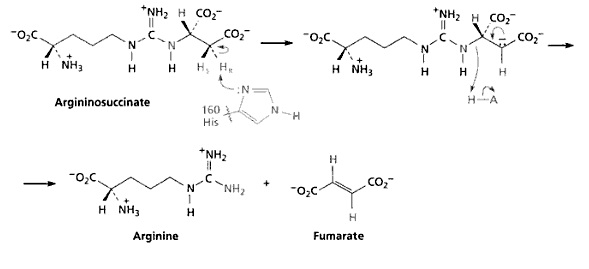Sandbox Reserved 649
From Proteopedia
| This Sandbox is Reserved from 30/08/2012, through 01/02/2013 for use in the course "Proteins and Molecular Mechanisms" taught by Robert B. Rose at the North Carolina State University, Raleigh, NC USA. This reservation includes Sandbox Reserved 636 through Sandbox Reserved 685. |
To get started:
More help: Help:Editing For more help, look at this link: http://proteopedia.org/w/Help:Getting_Started_in_Proteopedia
Mechanism[1]The third step of the urea cycle is catalyzed by argininosuccinate lyase. The products of this reaction are arginine and fumarate. The fumarate product is an important link between the urea cycle and the citric acid cycle. The base initiates the reaction by deprotonating the carbon adjacent to the arginine, or leaving group. The process occurs by an E1cB mechanism with loss of the pro-R hydrogen (the hydrogen that will geive the R configuration of a molecule after it is abstracted) and with anti-stereochemistry. The E1cB elimination reaction is a special type of elimination reaction in organic chemistry. This reaction mechanism explains the formation of alkenes from mostly alky halides through a carbanion intermediate given specified reaction condition and specified substrates. There are some evidences have shown that Histidine 162 or Threonine 161 of ASL is responsible for the proton abstraction of the carbon, either directly or indirectly. ImplicationsArgininosuccinic aciduria is an inherited disorder cause by the mutations in the ASL gene. Argininosuccinate lyase deficiency is a urea cycle disorder which can present in the neonatal period or later in the childhood; this is a rare, autosomal recessive disorder. Argininosuccinate lyase is an intermediate enzyme in the urea synthesis pathway and its function is imperative to the continuation of the cycle. As result of this enzyme defect patients have increased ammonia, argininosuccinate, and citrulline accumulates in the blood. Ammonia builds to toxic levels, resulting in hyperammonnemia and may affect the nervous and eventually damage the liver.[2] There is biochemical evidence that shows rises in ammonia can inhibit glutaminase and therefore limit the rate of synthesis of neurotransmitters such as glutamate, which could lead to the developmental delay in argininosuccinic aciduria patients. People who has Argininosuccinic aciduria may be lacking in energy or unwilling to eat, and have poorly controlled breathing rate or body temperature. People may also experience seizures or unusual body movements, or go into a coma.[3] References1. Ficicioglu C, Mandell R, Shih VE (November 2009). "Argininosuccinate lyase deficiency: longterm outcome of 13 patients detected by newborn screening". Mol. Genet. Metab. 98 (3): 273–7. 2. The organic chemistry of biological pathways: McMurry, John, and Begley, Tadhg. Frank Vella. Article first published online: 3 NOV 2006. 3. Jack, JJB (1982). "Actions of ammonia on the central nervous system". Journal of Inherited Metabolic Disease 5 (S2): 104 |

